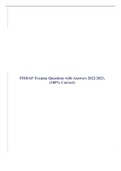EMERGENCYSERVICES100 (EMERGENCYSERVICES100)
Durham Technical Community College
All 6 results
Sort by

-
FISDAP Airway Questions with Answers.
- Exam (elaborations) • 16 pages • 2023
-
- $13.00
- + learn more
FISDAP Airway Questions with Answers.1. Where does the stimulus to breathe originate? A. Spinal cord B. Diaphragm C. Heart D. Brainstem 2. What is the proper way to measure an oropharyngeal airway? A. The nose to the xyphoid process. B. From the center of the mouth to the angle of the jaw. C. From the tip of the nose to the lobe of the ear. D. By the size of the patients thumb. 3. During respiration, where does the process of the gas exchange occur? A. Trachea B. Aveoli C. E...

-
FISDAP OBGYN Questions with Answers.
- Exam (elaborations) • 8 pages • 2023
-
- $10.00
- + learn more
FISDAP OBGYN Questions with Answers.1. You notice a brownish green fluid pasing from a 23 year old female while giving birth. What should you do? A. Using a gloved hand prevent the fetus from fully delivering. B. Using a glove hand attempt to visualize the cord for a rupture. C. Stimulate the fetus immediately after delivery. D. Suction the mouth and nose of the fetus after delivery. 2. A 36 year old pregnant female has severe abdominal pain. In what position you transport her? A. Supine...

-
FISDAP Operations Questions with Answers.
- Exam (elaborations) • 11 pages • 2023
-
- $15.00
- + learn more
FISDAP Operations Questions with Answers.Operations Exam Practice Questions 1. What is your priority as the incident commander at a mass casualty incident? A. Ensuring safety of EMS personnel. B. Monitor incident organization. C. Directing extrication of casualties. D. Notification of the media. 2. You are the first ambulance to arrive on the scene of a school bus rollover. The fire department has stabilized the bus. What should you do? A. Have your partner begin triaging patients. B. ...

-
FISDAP Medical Questions with Answers.
- Exam (elaborations) • 38 pages • 2023
-
- $15.00
- + learn more
FISDAP Medical Questions with Answers.1. What is the effect of oral glucose? A. Lowers blood sugar B. Raises blood sugar C. Stimulates gluconeogenesis D. Increases the rate of digestion 2. A 14 year old male is hot, dry and complaining of nausea and vomiting after mowing the lawn. What should you suspect? A. Hypothermia B. Heat exhaustion C. Heat stroke D. Hyperemesis 3. What occurs during compression of the inferior vena cava? A. Preeclampsia B. Supine hypotensive syndrome...

-
FISDAP Trauma Questions with Answers.| VERIFIED ANSWERS
- Exam (elaborations) • 27 pages • 2023
-
- $16.00
- + learn more
FISDAP Trauma Questions with Answers.1. An alert 18 year old female is found trapped in her car after a single motor vehicle crash. The air bag deployed and she denies any head or neck pain, but she complains of hip and left leg pain. When she is finally extricated from the car, her vital signs begin to collapse. What shock is she transitioning from? A. neurogenic shock to hypovolemic shock. B. decompensated shock to compensated shock. C. compensated shock to decompensated shock. D. decompen...

-
FISDAP Trauma Questions with Answers 2022/2023, (100% Correct)
- Exam (elaborations) • 27 pages • 2023
-
- $10.49
- + learn more
1. An alert 18 year old female is found trapped in her car after a single motor vehicle crash. The air bag deployed and she denies any head or neck pain, but she complains of hip and left leg pain. When she is finally extricated from the car, her vital signs begin to collapse. What shock is she transitioning from? A. neurogenic shock to hypovolemic shock. B. decompensated shock to compensated shock. C. compensated shock to decompensated shock. D. decompensated shock to hypovolemic shock. 2. Whic...



